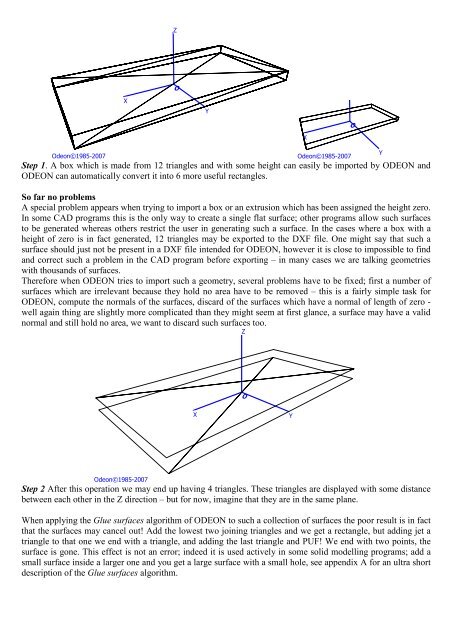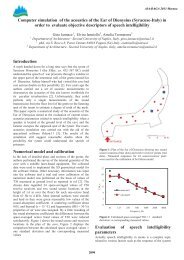ODEON Import of CAD files in the DXF format â problems and ...
ODEON Import of CAD files in the DXF format â problems and ...
ODEON Import of CAD files in the DXF format â problems and ...
Create successful ePaper yourself
Turn your PDF publications into a flip-book with our unique Google optimized e-Paper software.
Z<br />
O<br />
X<br />
Y<br />
O<br />
Odeon©1985-2007<br />
X<br />
Odeon©1985-2007<br />
Step 1. A box which is made from 12 triangles <strong>and</strong> with some height can easily be imported by <strong>ODEON</strong> <strong>and</strong><br />
<strong>ODEON</strong> can automatically convert it <strong>in</strong>to 6 more useful rectangles.<br />
So far no <strong>problems</strong><br />
A special problem appears when try<strong>in</strong>g to import a box or an extrusion which has been assigned <strong>the</strong> height zero.<br />
In some <strong>CAD</strong> programs this is <strong>the</strong> only way to create a s<strong>in</strong>gle flat surface; o<strong>the</strong>r programs allow such surfaces<br />
to be generated whereas o<strong>the</strong>rs restrict <strong>the</strong> user <strong>in</strong> generat<strong>in</strong>g such a surface. In <strong>the</strong> cases where a box with a<br />
height <strong>of</strong> zero is <strong>in</strong> fact generated, 12 triangles may be exported to <strong>the</strong> <strong>DXF</strong> file. One might say that such a<br />
surface should just not be present <strong>in</strong> a <strong>DXF</strong> file <strong>in</strong>tended for <strong>ODEON</strong>, however it is close to impossible to f<strong>in</strong>d<br />
<strong>and</strong> correct such a problem <strong>in</strong> <strong>the</strong> <strong>CAD</strong> program before export<strong>in</strong>g – <strong>in</strong> many cases we are talk<strong>in</strong>g geometries<br />
with thous<strong>and</strong>s <strong>of</strong> surfaces.<br />
Therefore when <strong>ODEON</strong> tries to import such a geometry, several <strong>problems</strong> have to be fixed; first a number <strong>of</strong><br />
surfaces which are irrelevant because <strong>the</strong>y hold no area have to be removed – this is a fairly simple task for<br />
<strong>ODEON</strong>, compute <strong>the</strong> normals <strong>of</strong> <strong>the</strong> surfaces, discard <strong>of</strong> <strong>the</strong> surfaces which have a normal <strong>of</strong> length <strong>of</strong> zero -<br />
well aga<strong>in</strong> th<strong>in</strong>g are slightly more complicated than <strong>the</strong>y might seem at first glance, a surface may have a valid<br />
normal <strong>and</strong> still hold no area, we want to discard such surfaces too.<br />
Z<br />
Y<br />
O<br />
X<br />
Y<br />
Odeon©1985-2007<br />
Step 2 After this operation we may end up hav<strong>in</strong>g 4 triangles. These triangles are displayed with some distance<br />
between each o<strong>the</strong>r <strong>in</strong> <strong>the</strong> Z direction – but for now, imag<strong>in</strong>e that <strong>the</strong>y are <strong>in</strong> <strong>the</strong> same plane.<br />
When apply<strong>in</strong>g <strong>the</strong> Glue surfaces algorithm <strong>of</strong> <strong>ODEON</strong> to such a collection <strong>of</strong> surfaces <strong>the</strong> poor result is <strong>in</strong> fact<br />
that <strong>the</strong> surfaces may cancel out! Add <strong>the</strong> lowest two jo<strong>in</strong><strong>in</strong>g triangles <strong>and</strong> we get a rectangle, but add<strong>in</strong>g jet a<br />
triangle to that one we end with a triangle, <strong>and</strong> add<strong>in</strong>g <strong>the</strong> last triangle <strong>and</strong> PUF! We end with two po<strong>in</strong>ts, <strong>the</strong><br />
surface is gone. This effect is not an error; <strong>in</strong>deed it is used actively <strong>in</strong> some solid modell<strong>in</strong>g programs; add a<br />
small surface <strong>in</strong>side a larger one <strong>and</strong> you get a large surface with a small hole, see appendix A for an ultra short<br />
description <strong>of</strong> <strong>the</strong> Glue surfaces algorithm.
















